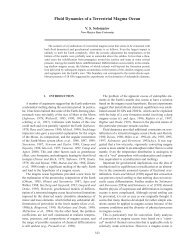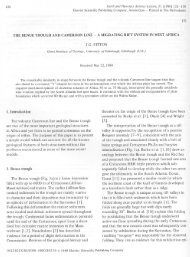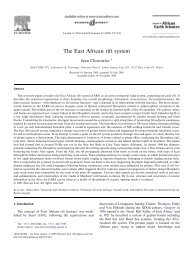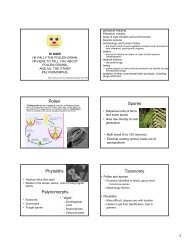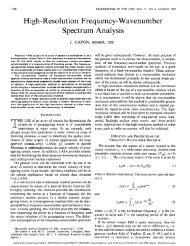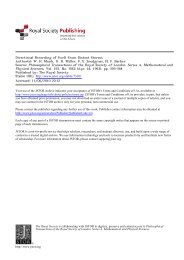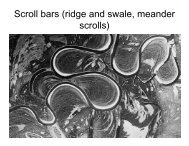Jeroen Tromp
Jeroen Tromp
Jeroen Tromp
You also want an ePaper? Increase the reach of your titles
YUMPU automatically turns print PDFs into web optimized ePapers that Google loves.
Spectral-Element and Adjoint Methods inSeismology<strong>Jeroen</strong> <strong>Tromp</strong>Min Chen, Vala Hjorleifsdottir, Dimitri Komatitsch, Swami Krishnan, Qinya Liu,Alessia Maggi, Anne Sieminski, Carl Tape & Ying Zhou
Introduction to the Spectral-Element Method(SEM)
Governing EquationsEquation of motion:Boundary condition:Initial conditions:Earthquake source:
Weak Form• Weak form valid for any test vector• Boundary conditions automatically included• Source term explicitly integratedFinite-fault (kinematic) rupture:
Finite-ElementsMapping from reference cube to hexahedral elements:Volume relationship:Jacobian of the mapping:Jacobian matrix:
Lagrange Polynomials and Gauss-Lobatto-Legendre (GLL) PointsThe 5 degree 4 Lagrange polynomials:Degree 4 GLL points:General definition:GLL points are n+1 roots of:Note that at a GLL point:
InterpolationRepresentation of functions on an element in terms of Lagrange polynomials:Gradient on an element:
IntegrationIntegration of functions over an element based upon GLL quadrature:• Integrations are pulled back to the reference cube• In the SEM one uses:• interpolation on GLL points• GLL quadratureDegree 4 GLL points:
The Diagonal Mass MatrixRepresentation of the displacement:Degree 4 Lagrange polynomials:Representation of the test vector:Weak form:Diagonal mass matrix:• Integrations are pulled back to the reference cube• In the SEM one uses:• interpolation on GLL points• GLL quadratureDegree 4 GLL points:
AssemblyNeed to distinguish:• local mesh• global meshEfficient routines availablefrom FEM applicationsGlobal equations:Global SEM time-marching isbased upon an explicitsecond-order time scheme
Parallel ImplementationGlobal mesh partitioning:Regional mesh partitioning:Cubed Sphere: 6 n2mesh slicesn x m mesh slices
Basin Code: SPECFEM3D_BASIN• Freely available for non-commercial use from geodynamics.org• Manual available at geodynamics.org• 3D Attenuation• 3D Anisotropy• Ocean load• Topography & bathymetry• Kinematic ruptures• Movies• Models:– Harvard 3D Southern California model– SOCAL 1D model– Homogeneous half-space model• Adjoint capabilities
Southern California Simulations100-10-20-30100-10-20-30A A’0 50 100 150 200 250 300 350 400 450B B’0 50 100 150 200 250 300 350 4002 3 4 5 6 7 8Vp(km/s)n x m mesh slices
Periods > 2 sKomatitsch et al. 2004
June 12, 2005, M=5.1 Big BearQuickTime and aYUV420 codec decompressorare needed to see this picture.
3D Regional Forward SimulationsPeriods > 6 s379 kmJune 12, 2005, M=5.1 Big Bear100kmQinya Liu
San Andreas Rupture ScenarioQuickTime and aYUV420 codec decompressorare needed to see this picture.
San Andreas Rupture Scenario:Quantitative Seismic Hazard AssessmentSwami Krishnan
Near Real-Time Applications• Automated near real-time simulations of all M>3.5 events• ShakeMovies at http://www.shakemovie.caltech.edu/• Soon:– CMT solutions– Synthetic seismograms
SPECFEM3D_BASIN: Future Plans• Switch to a (parallel) CUBIT hexahedral finite-element mesher (Casarotti, Lee)– Topography & bathymetry– Major geological interfaces– Basins– Fault surfaces• Use ParMETIS or SCOTCH for mesh partitioning & load-balancing• Retain the SPECFEM3D_BASIN solver (takes ParMETIS meshes; Komatitsch)• Add dynamic rupture capabilities (Ampuero, Lapusta, Kaneko)Taipei Basin102kmN88km100kmS.-J. Lee
Global Code: SPECFEM3D_GLOBE• Freely available for non-commercial use from geodynamics.org• Manual available at geodynamics.org• 3D Attenuation• 3D Anisotropy• Ocean load• Topography & bathymetry• Rotation• Self-gravitation (Cowling approximation)• Kinematic ruptures• Movies• Models:– 1D models: isotropic PREM, transversely isotropic PREM, AK135, IASP91, 1066A– S20RTS– Crust2.0• Adjoint capabilities
Global SimulationsPREM benchmarksCubed sphere meshParallel implementation:26 n mesh slices
SEM Implementation of AttenuationAnelastic, anisotropic constitutive relationship:Equivalent Standard Linear Solid (SLS) formulation:Attenuation (3 SLSs)Memory variable equation:Unrelaxed modulus:Modulus defect:Physical dispersion (3 SLSs)
Effect of Attenuation
Attenuation
Effect of Anisotropy
SEM Implementation of Anisotropy
Antipodal Transverse Record
Vertical PKP
Rotation & Self-GravitationWave equation solved by SPECFEM3D_GLOBE in crust, mantle and inner core:Wave equation solved by SPECFEM3D_GLOBE in fluid outer core:SPECFEM3D_GLOBE uses domain decomposition between the fluid outer coreand the solid inner core and mantle matching exactly:• continuity of traction• continuity of the normal component of displacement
Full Gravity Versus Cowling
SEM Implementation of Gravity
Effect of Ocean
SEM Implementation of OceanModified boundary condition:
3D Mantle ModelsS20RTS (Ritsema et al. 1999)
Crustal and Topographic ModelsCrust 2.0 (Bassin et al. 2000)ETOPO5
Great 2004 Sumatra-Andaman EarthquakeFinite slip model (Chen et al., 2005)Main shock & aftershocks (Harvard)
Sumatra Surface WavesQuickTime and aYUV420 codec decompressorare needed to see this picture.
Surface-Wave FitsVala Hjorleifsdottir
SPECFEM3D_GLOBE: Future PlansOn-demand TeraGrid applications:• Automated, near real-time simulations of all M>6 earthquakes• Analysis of past events (more than 20,000 events)• Seismology Web Portal (prototype available at this meeting)Petascale simulations:• Global simulations at 1-2 Hz• New doubling brick(perfect load-balancing)
Adjoint Spectral-Element Simulations(ASEM)
Adjoint TomographyPDE-constrained waveform tomography:Change in the waveform misfit function:
Adjoint EquationsAdjoint wavefield:Adjoint equation of motion:Adjoint boundary conditions:Adjoint initial conditions:Adjoint source:
Frechet derivativeThe Frechet derivative may be expressed as:Density and elastic tensor kernels:
Isotropic KernelsFor isotropic perturbations we have:whereand we have defined the strain deviatorsIn terms of wave speeds:where
Traveltime Frechet DerivativesTraveltime tomography:Change in the misfit function:Traveltime anomaly in terms of banana-donut kernel (Dahlen):The kernel is a weighted sum of banana-donut kernels :
Adjoint WavefieldKernel in terms of the adjoint wavefield:The adjoint wavefieldis generated by the adjoint sourceNotes:• Need simultaneous access to the regular wavefield at time t and the adjointwavefield at time T – t• Use of the time-reversed velocity as the source for the adjoint wavefield
Numerical ImplementationNeed simultaneous access to and• During calculation of adjoint field ,reconstruct by solving the `backward’ waveequationNeed to store from a previous forward simulation:– Last snapshot– Wavefield absorb on artificial boundariesChallenge:– `Undoing’ attenuation
2D Adjoint Tomography
Construction of a Banana-Donut KernelTape et al. 2006
Adjoint Tomography
Construction of an Event KernelEvent Kernel:• Sum of weighted bananadonutkernels• Two simulations per event
Construction of the Misfit KernelMisfit kernel:• Sum of all the event kernels• Two simulations per event• Gradient of misfit function
Conjugate Gradient Algorithm
Conjugate Gradient Algorithm
Joint Structure-Source Inversion
Southern California Rayleigh Waves25 events
Toward 3D Tomography: SPECFEM3DAdjoint Capabilities
3D Sensitivity KernelsSSSPSPSSPECFEM3D_BASINLiu & <strong>Tromp</strong> 2006
3D Body-Wave Sensitivity KernelsSeptember 3, 2002,M=4.2 Yorba Linda
3D Surface-Wave Sensitivity KernelsRayleigh (HEC)Love (HEC)
Our First 3D Event Kernels!
Global 3D Body-Wave Sensitivity KernelsFinite-Frequency effects20 second P wave9 second P waveSPECFEM3D_GLOBEQinya Liu
Global 3D Body-Wave Sensitivity KernelsPdiffPKPScSSKSQinya Liu
PKP Kernel
P’P’ KernelLiu & <strong>Tromp</strong> 2006
Global 3D Transversely Isotropic KernelsαhPαvαhSHαvβhβvβhβvηρηρAnne Sieminski
Transversely IsotropicParameters: A, C, L, N, F1 ζ: J, K, M2 ζ: G, B, H3 ζ: D4 ζ: EAnne Sieminski
1D Versus 3D Kernels1D3DYing Zhou
Time-Reversal Imaging: GlacialEarthquakesGreenlandCarene Larmat
Measuring all available Phase &Amplitude Anomalies
Measure all suitable phasesRARF2=0.93dT=1.00F2=0.83dT=1.00F2=0.83dT=6.00F2=0.68dT=2.00F2=0.78dT=-1.00PP PKiKPpPKiKPsPKiKPSKiKPSKSac SSKKSacpSKSac pSsSKSac sSP PcP pP ScS SPnsP PnS SSSKKSdfSKKSacP’P’df400 800 1200 1600 2000 2400 2800 3200 3600 4000Time (s)SeismogramsANMOF2=0.91F2=0.93F2=0.68F2=0.92F2=0.91F2=0.83F2=0.84F2=0.83F2=0.69F2=0.85F2=0.91F2=0.92F2=0.51F2=0.61F2=0.66400 800 1200 1600 2000 2400 2800 3200 3600 4000Time (s)Alessia Maggi
ConclusionsAdjoint methods:• Choose an observable, e.g., waveforms or cross-correlation traveltimes• Choose a measure of misfit, e.g., least-squares• Determine the appropriate adjoint source for this observable & measurement• Use fully 3D reference models• Any arrival suitable for measurement• No dependence on the number of stations, components, or measurements• 3D sensitivity kernels may be calculated based upon two forward simulations for each earthquake• Number of simulations: 3 * (# earthquakes) * (# iterations)• Full anisotropy for the same cost• Attenuation remains a challengeRegional simulations:• One 3 minute forward simulation accurate to 1.5 seconds takes 45 minutes on a 75 node cluster• 150 events and 3 iterations would require 1800 simulations, i.e., three weeks of dedicated CPU time on75 nodes• Near real-time simulationsGlobal simulations:• One 1 hour forward simulation accurate to 20 seconds takes 4 hours on a 75 node cluster• 500 events and 3 iterations would require 6,000 simulations, i.e., 100 days on a 750 node cluster• Near real-time simulations• On-demand global seismology• Petascale application




